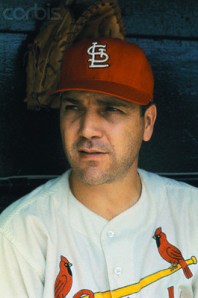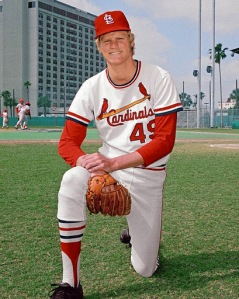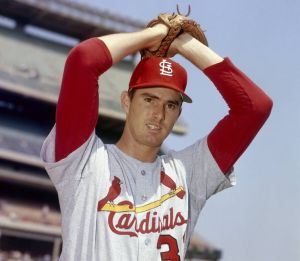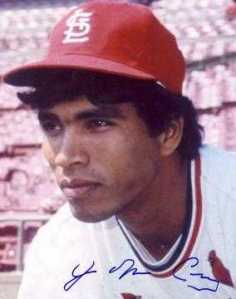Yes, the last few months have been something of a roller coaster for the emotions of Cardinals fans. The final resolution of the Colby Rasmus drama, the disillusion of early August, the hope of September and awe of October. Throw in Tony La Russa’s surprise retirement, the hiring of Mike Matheny as his replacement. There was one more thing – now, what was it ? ……. Oh, yeah, Albert Pujols is now a member of the Angels.
Over the course of the coming days, we are likely to learn more about this, and some of it might not be to our liking. It may significantly alter our perceptions of people, for the good or bad. But, historically speaking, what Albert Pujols just did to the Cardinals and their fans is nothing compared to what the organization has done to players in the past.
Before I get started, some of this happened during the reserve clause era, when owners essentially had complete control over a player’s career. If a player was injured, in a prolonged slump or just fell out of favor for whatever reason, they could be shipped off in the dead of night to team, not of their choosing. It was a different time and most of our Cardinals heroes played under those rules. We need to bear that in mind when we think of Albert Pujols in the future.
Let’s take a look at some of these and perhaps we will feel a bit better about what just happened.
 Ken Boyer – All Ken Boyer did for the Cardinals was be the second best player to Stan Musial throughout his career. Boyer was to the 60’s Cardinals what Scott Rolen was to the MV3 era (Bill White completing that MV3). Over 11 seasons, he collected 1,855 hits, 255 home runs, 1,001 RBIs, won 5 Gold Gloves, one league MVP and hit a game winning grand slam in the World Series. Back problems started interfering with his production in 1965 and following the disappointing season, he was sent off to the New York Mets. In those days, that was the baseball equivalent of being sent to Siberia – cold, dark, hostile, nobody wanted to play there. Way to treat a Cardinals legend, Mr. Howsam. His power numbers dropped off, but he still had a couple of good season before retiring in 1969.
Ken Boyer – All Ken Boyer did for the Cardinals was be the second best player to Stan Musial throughout his career. Boyer was to the 60’s Cardinals what Scott Rolen was to the MV3 era (Bill White completing that MV3). Over 11 seasons, he collected 1,855 hits, 255 home runs, 1,001 RBIs, won 5 Gold Gloves, one league MVP and hit a game winning grand slam in the World Series. Back problems started interfering with his production in 1965 and following the disappointing season, he was sent off to the New York Mets. In those days, that was the baseball equivalent of being sent to Siberia – cold, dark, hostile, nobody wanted to play there. Way to treat a Cardinals legend, Mr. Howsam. His power numbers dropped off, but he still had a couple of good season before retiring in 1969.
Sure, Boyer’s offensive numbers started to decline following the historic 1964 season, but let’s keep in perspective that an injured Boyer was a lot better than any of the healthy alternatives, including Mike Shannon. What the Cardinals did to Boyer was embarrassing, he should have retired a Cardinal, with one more World Series ring.
 Jack Clark – There was no more feared hitter in the National League than Jack Clark when he played in St. Louis. He was the lone power bat in the lineup, but his skills matched perfectly with the speed ahead of him in the batting order. How many times did we see a first inning that went walk, stolen base, bunt and sac fly or RBI single from The Ripper ? Let’s also not forget his offensive assault in 1987. He put up steroids era power numbers in that ghastly home run grave yard at old Busch Stadium, and it was just amazing. The only other player to do that was Richie Allen, who we will get to later.
Jack Clark – There was no more feared hitter in the National League than Jack Clark when he played in St. Louis. He was the lone power bat in the lineup, but his skills matched perfectly with the speed ahead of him in the batting order. How many times did we see a first inning that went walk, stolen base, bunt and sac fly or RBI single from The Ripper ? Let’s also not forget his offensive assault in 1987. He put up steroids era power numbers in that ghastly home run grave yard at old Busch Stadium, and it was just amazing. The only other player to do that was Richie Allen, who we will get to later.
Even though Clark missed the last month of the 1987 season, and all of the postseason, he still came in third in MVP voting. He also led the league in on-base percentage (.459), slugging (.597), OPS (1.055) and OPS+ 176. Yes, this is Jack Clark, not Albert Pujols. Clark was also in the final year of his contract and was rewarded by the sounds of crickets from the Cardinals front office.
He made $1.3M in 1987 and the Cardinals just let him walk away, rather than giving him the contract he deserved. The winter meetings had passed and Clark finally signed a contract with the Yankees for $1.5M in early January. Hardly bolting to sunny California for millions of dollars.
Surprisingly, Clark proved to be somewhat more durable in his final years with New York, San Diego and Boston. His production was not up to his St. Louis levels, but he still managed 111 home runs, 369 RBIs and an OPS+ of 133 (let’s say he was well above average).
The Cardinals were rewarded for the treatment of Jack Clark by some of the worst and most uninspired baseball in franchise history. It wasn’t just Clark, the team ran off every player as they approached a big pay day. Terry Pendleton, Gregg Jefferies, Milt Thompson. I guess you could put Todd Zeile in this group, but the front office might have actually gotten that one right.
 Orlando Cepeda – Cha Cha, or Baby Bull if you prefer, was just as popular in St. Louis during the 1967 and 1968 seasons as Albert Pujols has been in the last decade. In 1967, his production was just as impressive. Although he faded at the end of the season, Cepeda put up some monstrous numbers and slugged his way to the NL MVP. The Red Sox did a good job containing him in the World Series, but Cepeda was a big reason they were in the fall classic.
Orlando Cepeda – Cha Cha, or Baby Bull if you prefer, was just as popular in St. Louis during the 1967 and 1968 seasons as Albert Pujols has been in the last decade. In 1967, his production was just as impressive. Although he faded at the end of the season, Cepeda put up some monstrous numbers and slugged his way to the NL MVP. The Red Sox did a good job containing him in the World Series, but Cepeda was a big reason they were in the fall classic.
Following the 1968 World Series, Cepeda was traded to Atlanta for Joe Torre. Cepeda struggled a bit in his first season with the Braves, but returned to nearly his 1967 form the following year. Injuries cut short his 1971 and 1972 seasons, but he roared back with another solid year in 1973. Cepeda’s career was far from over and the Cardinals were foolish for sending him away after the 1968 season. Like with Clark, a number of dark years followed his departure.
Cepeda should have retired a Cardinal and maybe then his Hall of Fame plaque would have the Birds on the Bat instead of the Giants logo.
 Jerry Reuss – this one really boggles the mind. Here you have a hometown kid, grew up watching the Cardinals play, is a 6ft 6in lefty that looks like he can throw a billion innings, and he gets run out of town because of a little bit of facial hair ? Gussie’s vision had to be a lot better than mine, because I had a hard time seeing it.
Jerry Reuss – this one really boggles the mind. Here you have a hometown kid, grew up watching the Cardinals play, is a 6ft 6in lefty that looks like he can throw a billion innings, and he gets run out of town because of a little bit of facial hair ? Gussie’s vision had to be a lot better than mine, because I had a hard time seeing it.
That decision cost the Cardinals 198 wins over the next 19 seasons, over 3,000 innings pitched, some great post-season games and a no-hitter. The Cardinals lost the NL East by 1 game in 1974. Jerry Reuss won 16 games FOR THE TEAM THAT BEAT THE CARDINALS.
 Steve Carlton – do I really need to mention this ? Just thinking about it makes me want to go into a corner and cry. 252 wins, nearly 4,000 innings pitched, over 3,000 strikeouts – and that’s after Lefty was run out of town. Steve Carlton should have retired a Cardinal and have his statue right beside Bob Gibson’s. Albert Pujols will earn more with each base hit than what Carlton was paid in St. Louis. One of the greatest left handers of the era, run out of town. Mr. Pujols, I think we’re even on this one alone.
Steve Carlton – do I really need to mention this ? Just thinking about it makes me want to go into a corner and cry. 252 wins, nearly 4,000 innings pitched, over 3,000 strikeouts – and that’s after Lefty was run out of town. Steve Carlton should have retired a Cardinal and have his statue right beside Bob Gibson’s. Albert Pujols will earn more with each base hit than what Carlton was paid in St. Louis. One of the greatest left handers of the era, run out of town. Mr. Pujols, I think we’re even on this one alone.
 Mike Torrez – Now here’s a guy you don’t hear much about, but he was quite an impressive prospect. One of the hardest thrower’s I’ve ever seen (or heard). Even Bob Gibson would turn his head when Torrez threw a bullpen.
Mike Torrez – Now here’s a guy you don’t hear much about, but he was quite an impressive prospect. One of the hardest thrower’s I’ve ever seen (or heard). Even Bob Gibson would turn his head when Torrez threw a bullpen.
After being traded away, Torrez turned in 7 15+ win seasons, including one 20 game with Baltimore in 1975. Torrez and Reuss should have been the next Gibson and Carlton. Both, maybe either, could have brought postseason back to St. Louis long before 1982.
 Jose Cruz – a .291 batting average, 1,953 hits, 139 home runs and 949 RBIs over the 14 years after he was sold SOLD to the Houston Astros. We didn’t even get a player in return for Cruz, just cash to keep the Brewery in operation.
Jose Cruz – a .291 batting average, 1,953 hits, 139 home runs and 949 RBIs over the 14 years after he was sold SOLD to the Houston Astros. We didn’t even get a player in return for Cruz, just cash to keep the Brewery in operation.
At one time, all three Cruz brothers (Jose, Tommy and Hector) were on the Cardinals roster. It was late in the 1973 season. Although his hitting was still a bit inconsistent, Jose had become an every day outfielder. Tommy and Hector were both called up to join their older brother. Tommy’s major league career was brief, but Hector went on to have a good 9 year career. If you are wondering, no – the three of them never played in the same game.
The problem came when Cruz was due a big pay day in 1975. The Cardinals were a bit cash strapped, so off to Houston went the elder Cruz and bye bye went the playoff chances for the Cardinals.
Scott Rolen – all he did was play hard for the Cardinals. It was a run in with Hee Sop Choi that led to later run ins with Tony La Russa, and the fan favorite was shipped out of town. Rolen is another player that should have retired a Cardinal (like Ken Boyer). For all that I love about Tony La Russa’s time in St. Louis, the Rolen fiasco is not one of them.
This is just the tip of the iceberg. We could go on about Richie Allen, Reggie Smith, Lance Johnson, Willie McGee, Ray Lankford, Bernard Gilkey, Terry Pendleton, Tim McCarver, Curt Flood, John Tudor, Andy Benes, Todd Worrell, Ted Simmons, Andy van Slyke, Tommy Herr.
Try to come up with a list of similar players that have walked away from the Cardinals organization, as Albert Pujols just did. I’ll wait……. No, go on, it’s OK, we have time. I could come up with 2, and one of them is marginal. Bruce Sutter left St. Louis after a monster 1984 season, just days into the free agency season. That actually hurt a lot more than what Pujols just did because he totally blind-sided the Cardinals and left them without a closer.
The other name that you might come up with is Edgar Renteria, following the 2004 World Series. He didn’t leave for a huge amount of money ($8M vs $7.25 in 2004), so I really put Renteria in with the others, pushed out in favor of a lower cost ($2.3M) option in David Eckstein.
Players like Bob Gibson and Stan Musial did not have much of an option, playing their entire career under the rules of the reserve clause. There were two others though that could have opted for free agency, but chose to stay in St. Louis – Lou Brock and Ozzie Smith. Brock was at the end of his career, and free agency had not reached the insanity that we see today, but it certainly was in full force during Ozzie Smith’s playing time. So if you ask the question, yes, there are examples of players choosing to stay in St. Louis for the remainder of their career. If you did a little deeper though, you may find out that the Cardinals have given the proverbial “finger” to far more players than have done that to St. Louis.
Just a thought to help you feel better about a Post-Pujols world.





Thanks for posting this.
LikeLike
Thanks, Daniel. Just wanted to point out how few players have done what Albert did. Bob Howsam sure did break a lot of eggs to make that 1967 omelet, didn’t he (White, Boyer). That was nothing compared to how Gussie treated players after those work stoppages, spring training holdouts and players wanting more money. Through all of that, we still love our Cardinals.
LikeLike
Great read. Thanks especially pointing out my two all-time favorite Cardinals, Brock and Smith. I had always hoped that the #5 would be mounted upon that wall with #1 and #20 (not to mention many others), but that was not something Albert was interested in. It’s also something that can’t be purchased. Good luck Albert. You, along with the player’s strike, the DH, interleague play and the Steroid Boys, have put another big bruise on my well-worn baseball psyche.
LikeLike
Thanks, Jeff. I can tell you are an old-school type of baseball fan. Me too 🙂 Brock and Smith had ample opportunity to go elsewhere, especially Ozzie, but they chose to finish their careers in St. Louis. As you say, apparently that isn’t as important to Albert, so he won’t be added to that collection of hometown heroes. Hopefully, players like Matt Holliday, Allen Craig, Chris Carpenter, Adam Wainwright plus a bunch of the kids coming up through the system will help with that bruised psyche. Even without Albert, there’s a lot to like about the current team and their future.
LikeLike
Very good points and good article all around. From a person standpoint though, I lost a lot of respect for Pujols after this. I had already lost respect for him when he decided to ask for $300 million from the Cardinals last off-season but I’ve definitely lost it for him now. I mean, sure that extra money is a lot for us normal people but when you have already had a $100 million contract and now you have a $200 million one, what do you need it for? He passes himself off as a man of the community but he really doesn’t prove it with his actions. If I’m a Cardinals fan I feel jobbed by him and I would be hoping for him to epically fail in Los Angeles. Who knows what will happen but it will definitely be interesting to monitor. Also, you think you could check out my blog because I’d really love to know what you think http://chrisross91.wordpress.com/2011/12/09/thank-you-albert-pujols/
LikeLike
You forgot Rogers Hornsby. Imagine that La Russa and Pujols are the same guy. Now, imagine trading that guy right after winning your first World Championship. That’s what the Cardinals did in 1927. And yet , life went on, and the Cardinals won four pennants and two more World Championships in the next eight years.
LikeLike
I hated to see Ken Boyer leave, but Kenny, who was a smoker, was going downhill pretty fast and was not in the same shape in his last major league years as he was in his star (core) years. Boyer should be in the Baseball Hall of Fame too, but it wasn’t necessarily a mistake to trade him. Moreover, the Cardinals might not have been able to hand out those 1967 World Series rings or enjoyed a 1968 NL pennant if Boyer had not been traded for Charlie Smith. One year later, Smith was dealt to the Yankees for Roger Maris, and Maris was a key in providing veteran leadership. Even as he was reduced to a platoon role, Maris plugged a major hole in RF. (Maris hit .385 in the 1967 World Series, with a homer and 7 RBI)
LikeLike
Jack Clark was unfortunately, a victim of two things: (1) A boneheaded agreement that MLB teams secretly made (which was exposed by the subsequent MLBPA grievance) in which owners agreed not to sign each other’s free agents. And (2) Clark’s personal spending was out of control, which fueled his salary demands. When the Cardinals acquired Clark from the Giants, the Cards had to pay off a $200,000 loan Clark received from San Francisco. Clark was spending much more money than he made, mostly by acquiring luxury cars. And he invested and owned a drag-racing business. According to Clark’s bankruptcy filing in 1992, he owned 18 luxury automobiles, including a $700,000 Ferrari and a Rolls Royce. In a spending frenzy which started when he was with the Giants and continued through his days with the Cardinals, Clark lived WAY beyond his means, and at one point was trying to pay 17 car notes simultaneously; whenever he got bored with a car he would get rid of it and just buy another one. He ended up losing million-dollar homes and his drag-racing business because of his extravagant spending habits.
When Clark came to the Cardinals in 1985, he was being paid more than Ozzie Smith. Smith eventually became the team’s highest paid player, and rightfully so. Clark’s contract negotiations with St. Louis in 1987 became contentious when Clark demanded that the team also pay off more private loans in addition to / outside his contract offer….because Clark had racked up another $200,000 in debt due to the continued uncontrolled extravagant spending.
Eventually the Cards and Clark reached a contract impasse, because Clark wouldn’t agree to get help in reining in his extravagant and unnecessary purchases. And George Steinbrenner and the Yankees broke ranks and crossed the owners’ “gentleman’s agreement” not to sign each other’s free agents.
Clark’s spending finally put him into bankruptcy and also cost Jack his marriage, as his wife filed for divorce in 1992….about the same time Jack lost his 18 luxury cars and other assets in his bankruptcy.
LikeLike
Orlando Cepeda had arthritic knees. He played two full years with Atlanta, and that was about all for his career. Orlando took advantage of the launching pad at Fulton County Stadium in Atlanta, but by the end of 1970 he was almost immobile in the field. He had “one more good year” with the Red Sox in 1973 because Boston used him as a DH…something that wasn’t available in the NL. The Cardinals got a lot more mileage out of Joe Torre in that deal (All-Star several more times, National League MVP in 1971 when Torre led the league with a .363 batting average and 137 RBI).
LikeLike